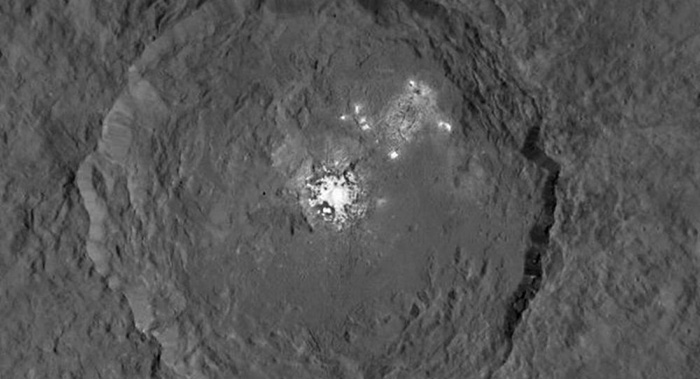“We are having difficulty understanding what made that mountain and we have been getting many suggestions from the public,” said Christopher Russell, Dawn’s principal investigator, at a conference in Nantes, France. “Maybe our lonely mountain was some sort of ice construct, we are taking suggestions like this very seriously.”
Sputnik has been keeping close eye on Ceres. We wrote three weeks ago about the now-famous lights inside Occator Crater, so we’ve had some time to come up with some of our own theories:
Occator Crater was clearly made from the impact, at some point, of another asteroid belt object. The lights in the center of the crater, and the lights to our visual Northeast of the center of the crater, are clearly from different formations within the crater. All are in the topographically deepest region of the crater’s impact zone.
If the “lights” are actually molten rock, it could be because the impact was relatively recent. This could be the case for the center of the crater itself, but not the seemingly disorganized lights off to the side.
The central lights could possibly be erupting ice — a cryovolcano. But again, this explanation doesn’t work for the lights off center, as water ice is not stable inside of 5 astronomical units (AU, a measurement equivalent to around 93 million miles) from the Sun. This also seems unlikely, though, as Ceres hasn’t shown us any similar light-emitting features anywhere on the surface outside of Occator. While other areas have appear to have amplified albedos, none match Occator.
Thus, we’re back at square one.
Now, we’ve played a lot of video games, and we’ve seen a lot of movies. We can’t help ourselves: what about aliens? Or, even, humans: maybe a secret NASA mission? An ancient space-faring civilization from Earth with an abandoned Helium-3 mine, to which Elon Musk (hitting the intergalactic convenience jackpot) just happens to be able to send rockets?
What if it’s the entrance to a subterranean ocean, like that on Saturn’s moon Enceladus, and there’s an advanced civilization of intelligent aquatic creatures deep underneath Ceres’ surface? Kanye West could have come from there.
We reached out to Russell, who heads up the Dawn probe.
“Dawn does measure over a spectrum of frequencies so it can measure heat and reflected light. It has not yet completed these studies,” he told Sputnik.
You’ve got our number, NASA. There’s more where this came from.
More about:












-1745485667.jpg&h=190&w=280&zc=1&q=100)



































